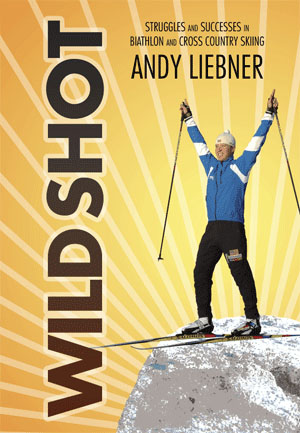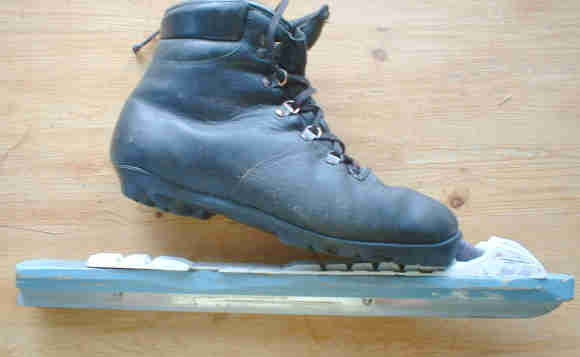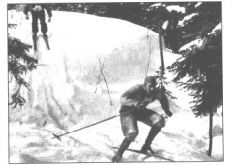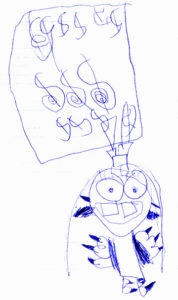Super XC Skiing with the Anikins
by Jeff Potter
Want to double your XC fun? I used to think I could ski classic style. I was known to have some of the better technique around; I even won a biathlon once using classic while others skated. I love classic. But I took a clinic from the former USSR Natl Coaches, Mr. and Mrs. Anikin, and they showed me I didn’t know much and gave me a whole new approach which doubled my already bigtime fun.
They say that what makes any skiing fun is only one thing: glide. They say that USSR skiers get much more glide than US skiers, that we’re not even in the ballpark. They also say that big glide is why skating is so much fun and best for kids.
But here’s a warning. Skiing is something that gets you outside and into the scenery. Exercise. Another mode of transpo. Except for the basics and racing, there’s no real reason to get into performance. Racing is a sacrifice you make for the sake of your community in honor of your hard-working neighbors. Sacrifice means that you SUFFER. You’re worse off. Don’t be fooled. Speed is relative and so is time. If you’re just racing to have fun, you don’t owe anything to anyone. The pursuit of technique can be a big time and money trap. Curiosity killed the cat. On the other hand, it’s good to know what works and why, it’ll even help you avoid injury. Each technique has its time and place. The Anikin method fits with racing and efficiency. Don’t just think that one type of skiing is better than another. There will be at least one clear indication of what I mean ahead.
So, how to get this great glide? Well, get a real stable base then do things that extend the power and duration of forces that go down the trail while minimizing friction. Ta dah!
Maybe one reason why people can classic ski so much faster nowadays is that we’ve tasted big glide via ski-skating. For me it’s almost a mind-over-matter thing which lets me take advantage of so many of the Anikin’s tips: I expect more now and know that the great glide of skating can be had with classic, too. I now expect to glide as far on each stroke in classic as I do in skating. And I make sure I do nothing to interrupt that glide, that float, that speed. It comes first. The dog wags the tail. Now it might be literally impossible to do in some cases, but! –Classic goes straight down the trail (while skating goes from side to side) letting you glide a little less to get equal results. Also, classic uses less effort per stroke, each stroke is ‘lighter’, so that shorter glide is acceptable since tempo is often higher. The brain knows this and easily concludes whether we’re ‘really movin’. In the end, I just make sure that with each stroke I ‘rocket on out’ and feel the windspeed and the big float of long glide. Anikin technique lets me do this.
Another great side effect for me of learning from the Anikins is that on somewhat-steeper-than-medium uphills I find that I can now classic faster than most ski skaters.
The trouble with learning is that I read an article on their tips and I saw photos before I took their clinic. I already thought I knew something of their method. I didn’t know jack. It might be a ‘you gotta be there’ thing. But I’ll tell ya what I know.
And of course we shouldn’t take this article as being their method. Only my memory of it! –From one clinic, several articles and much discussion elsewhere. I presume that I even include some notions which are contradictory. Just see what you can glean. And ideally take a clinic yourself! I believe they still take their show on the road, but their homebase is probably still Marquette, Michigan–home of a fine Olympic Training Center.
Now, this method is best used on tracks with racing skis and light poles. However the concepts can be applied when helpful in any situation. Basically, in ungroomed touring conditions you’re best to stay much more upright and maintain an inner center of gravity with less commitment to any pole or ski. But it’s still good to know what really makes technique work!
Jumping right in, they say that a high hip is the most stable. A hip which rests on a straightish leg, bone-on bone instead of using much muscle. Glide weight and kick weight on the HEEL. Don’t twist your body to go down the trail. These things allow stability.
With great stability you can slow your tempo down and not lose balance or increase tension. Or speed it up and stay smooth just the same.
Proper posture is SLUMPING. Let the arms and shoulders hang. Round the lower back even.
They have you practice by just slumping and swinging the arms naturally, letting them hang then fly up in front of the face, then throw them back.
They’re really big on relaxing. So keep your head in a neutral position in a straight line with your spine, which with a slumped posture means looking somewhat downward. See down the trail by lifting eyes. (This should be a warning flag if you ski to enjoy the scenery. But what does scenery matter to a race? To speed? It just so happens that you go your fastest the easiest with your head down. It’s the price you pay. I’d say it’s pretty steep. I’d say feel free to cheat here. But it’s good to know anyway just in case.) Anyway, they say that all skiing starts with the head position. It must be relaxed. I think they also said that relaxed deep breathing is also very important, but that it couldn’t be done with tension in the posture.
A great Anikin revolution comes with arms that are naturally ‘long’. They aren’t 100% straight, but they’ll feel three times as straight as you’re used to. This was a big surprise at the clinic. Nikolai kept grabbing my arm and making it straighter even though I thought it was straight. They want it to reach out the same way as it hangs. To practice the proper arm length, just let yourself slump over and swing your arms to the horizon, forward and back, naturally. That’s how ‘long’ your arms should be. This allows the lat’s to work and forces you to use torso power to load and push the poles since the arm muscles are somewhat cut out of the loop. Altho it does take a lot of arm effort. Now, other national teams teach arm use differently, like the Norwegians. Who knows if I’m even telling it right. Maybe Anikin just told us the intro stuff—how to get the right feel. When you’re finally rocketing down the trail at World class speed, maybe your technique can shift as needed.
They say to CUT THE STRINGS of the torso and to let it drop in a slump. This and the arm thing add up to a greater by far reach down the trail.
To power this poling they say to further ‘tip’ the torso down and drive with the hand rearward, closish to the ground.
One great check for proper hand height is that your hand should pass your leg at knee height. In singlestick, in doublepole…and even in skating. (Evidence that this tip has been accepted in skating is that the new motto is “go low” and poles are shorter than they were, to get more rearward thrust from a low hand.)
To get kick, reach forward as far as possible with the straightish leg, weight the heel and with that torso ‘tip’, ‘pop’ the heel straight back.
If the hips are kept high, the kick leg will fly back down the trail in the air (quit all effort of kick right after passing the hip), it will also be able to swing forward again without SLAPPING into the ground. A high hip will let the leg swing back easily without friction.
The kick foot is flat on the ground and heel-weighted until it passes under the hip where the whole foot is weighted. The ball hinges naturally as the leg flies away. Kick never comes from the ball. (However, as uphills steepen the kick does move forward in the foot and come closer to the hips and the ball is more involved. You try to swing the foot far up the hill, but as it steepens obviously you can’t reach up as far.)
Work on getting really deep ankle flex. Anikin also said that the best skiers keep their heel down longer than any other skiers. A 38-degree ankle flex is really good. Keeping heel down longer results in a longer, stronger kick.
They have you practice good leg-swing by standing humped over and swinging your leg forward and rearward without lifting your hip, just let the leg hang then swing forward and back.
A curved-out lower back actually takes work to achieve. It means tucking the butt under. It puts more force on the heel from pure body weight (thru the spine) instead of muscle, to get a more positive kick and it allows a further reach forward without twisting the hip. It’s also interesting that this technique is also mandatory in world-class level speed skating.
Such a positive kick lets you keep your wax in the kick zone, use the proper wax, and have a more reliable kick in varying conditions and fatigue levels. A muscle-activated kick results in more missed-kicks and often requires a softer wax to get the job done. In fact, most skiers I’ve seen sacrifice kick in order to get glide and end up suffering more on uphills and losing time there…to me! : )
This ‘pop!’ and ‘tip!’ actually involve you tipping forward off your heel and falling right on your nose unless you catch yourself with your pole. Most of the power comes from letting yourself fall forward like that. It’s a precise moment activated by body weight. This was also something that was much harder to learn than it sounds. In fact, it was my biggest problem…bigger than even the ‘straight arm’ dilemma. I didn’t realize how to really do it until we were all leaving from the clinic and Mrs. Anikin helped me one last time. I told her I was just somehow having trouble. And she said ‘Oh you, I know what you need’ and demonstrated the ‘tip!’ again by tipping forward off of the curb as she swung with arm and leg and dropped with torso and rocked forward with hip. Maybe she also grabbed me and pushed me over or something. Whatever it was, it worked finally.
Actually, she seems to be the brains behind this coaching duo. Their specialty is of course classic style and she was the big classic coach and had the best classic lady champs under her (their great champs were ladies in classic—total domination).
However, Nikolai is the gung-ho motivator. He also is adamant that skating is exactly like classic. This was hard for me to understand, but maybe it represents the next step forward in my skating skill! Since pole-length in skating is getting shorter, he is probably right. I don’t mean to question someone like him. What do I know? It’s just that the stepping forward and side-push and everything about skating seem different from classic. On the other hand, maybe not! Mainly, he said to use straight arms and the same posture in skating.
I know the US coaches have great argument with much of this. They say that the best racers use more dynamism in the legs, that the legs are bent more, same with the arms, and that the whole body leans forward, not just dropping from hips as though the string is cut. There is probably truth between the two. I suppose that one must master proper posture, relaxation and stability before one can add such dynamism. Anikin says the US has been far too much influenced by running and that we underappreciate glide. And obviously his style is not meant to increase rigidity in any sense. Who knows, probably both parties are true. All you can do is test and see for yourself. All I know is that I classic much faster and more comfortably with this method, and get much better glide.
Perhaps the best proof will be whether their help for the US team will produce results. However, even that comes with caveats: each skier is different. What brings the best out of one skier might not out of another. But results will be a clue. Maybe they’re already out there! Nina Kempel is our best skier now—is she an Anikin skier? I don’t know. I’m history. I just like to glide!
Any motion that isn’t forward or back down the trail, is wasted motion. The typical US skier twists a lot. Arms, legs, hands, hips–none of these things should wander across the centerline of the trail.
The end effect of the Anikin style is kind of like a scooter where each leg kicks but doesn’t stress or disturb the rest of the body, but just allows it to fly along. Also the torso feels kind of like a missle, it also isn’t disturbed much by the skiing. It feels like it’s being rocketed down the trail.
With a tipped-over torso, when the hand begins poling almost all forces are directed rearwards and the least possible forces are directed into the ground. The initial plant has more rearward vector, less downward.
This technique lets you slow down tempo without reducing power. Also stability isn’t disturbed. So you can singlestick when others doublepole. If you use a technique which has changing equilibrium, like foot-running, then you’ll always be hustling to catch up to your style. You won’t be able to independently add power without increasing tempo. The sign of stability is that your form doesn’t change with power, tempo or speed. When you want to sprint, a stable style allows you a much higher possible rpm as well. It’s almost like spinning a bike crank. High rpm disturbs nothing either.
They say to always prefer more glide to higher rpm. If you’re not going fast enough, calm down, get your form right and optimize your glide first, then increase tempo if you have to.
However, note that for uphills, the steeper the uphill the more the leg is bent, the less far up the hill it pushes and the lower to the ground and closer to the body the hands are and the torso is more upright (maybe). The butt still stays tucked under to increase kick, reach, etc. And one still skis with maximum glide per slope. This style still gives you much more extension and glide even on uphills as well as allowing for optimal transitions as the grade changes.
This method seems to make the greatest difference on medium uphills. Here you can fly. Of course, it also makes single-sticking on flats and slight ups a joy. And it eliminates the rushed feeling that can come when going up the steeps. So it’s great all around. I find I can go up hills much steeper than other folks before needing to herringbone.
Anyone who has tried it knows that classic training on roller skis is a kinda shaky proposition. Unless they’ve fixed the devices today somehow. Not to worry: the Anikins say that classic can be imitated with 95% accuracy on dryland. I find this to be so. Trail-bounding with poles lets you use the arm motion and leg action and torso slump just fine. You can really train the ‘pop’ and ‘tip’ of proper kick and poling. Since there’s so much energy released from this compression move, on dryland it might be easy to overwork and get out of breath. So the other skill you can work on is patience and timing. Slow down the tempo. This will represent your huge glide. It’s kinda like the sign that separates those who can really swim from those who can’t: those who can don’t have to rush, can slow tempo and maximize glide thru the water, like all the calm, slow old folks who swim past frantic youngsters.






